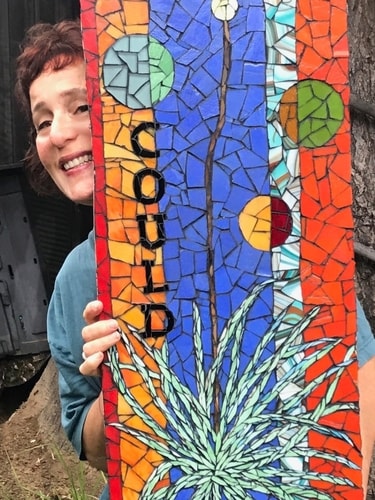Artist Carol Davis shares her inspiration and technique of using mosaic glass to create vibrant works of art. See more by visiting her website.

“Marble” Glass Mosaic, 13″ x 11″
Mosaics have a long history, starting in Mesopotamia in the 3rd millennium BC. They were typically made from clay tiles, pebbles and sometimes glass. They often depicted religious subjects or were purely decorative.

“Prance” Glass Mosaic, 14″ x 21″
I do mosaics differently.

“Penumbra” Glass Mosaic, 13″ x 11″
I grew up with art. My father was a painter and always had a painting he was working on in our den. I often got to go with him to the locations where he was working on a piece, and would watch him build that painting in real time from start to finish. It was really fascinating for me. He was an impressionist painter and mostly painted landscapes. I love his work.

“Gus” Glass Mosaic, 21″ x 28″
With mosaics, I love how the different bits come together to make a whole, which is Impressionistic as I see it.

“Sometimes” Glass Mosaic, 27″ x 34″
I was enticed to make mosaics as a means to interpret images and forms in ways different from painting, design and collage, all of which I have a background in.

“Would” Glass Mosaic, 28″ x 19″
Glass is transparent and opaque at the same time, and I love how the cuts are not perfect. I fully embrace the Japanese idea of Wabi Sabi, the beauty in imperfection.

“Limb” Glass Mosaic, 16″ x 22″
Stained-glass glass is the only type I use in my mosaics because the colors are so incredibly vibrant. I actually relish the constraints that the glass gives me. Since I cannot mix my own colors, this forces me to choose carefully when selecting colors and textures in each particular piece. It is creative problem solving at its finest.

“Sound” Glass Mosaic, 24″ x 32″
I see myself making mosaics differently than others do, by involving elements in a painterly way. Light logic, perspective, point of focus, balance, movement and proportion are all considered.

“Then” Glass Mosaic, 20″ x 27″
Often starting with a photograph that I’ve taken, I go from there by reinterpreting the colors and adding graphic elements. Sometimes I combine images, and sometimes I add words, which create another layer of consideration. This leaves it to the viewer to interpret the words as they see them within the context of the piece.

“Still” Glass Mosaic, 23″ x 32″
I appreciate ambiguity in art where each viewer can see and think about a piece in their own light. As a viewer, I like to come to art on my own terms, and I hope that my viewers do the same with my art.

Artist Carol Davis with her glass mosaic art
I am hoping my viewers will find my work unique and refreshing.




These mosaics are wonderful! They’re full in imagination, inspiration, beauty and whimsy.